Hello summer! Balmy weather stretches day into night so we only need come in from the garden when hunger strikes.
The southerly has come over night and cooled things down. It’s a great time to get out there in the garden. So lets get down to business.
It’s Time To:
Admire
Take in the Christmas reds of the Australian bush in the Illawarra flame tree, NSW Christmas bush and of course the show-stopping flowering gums.
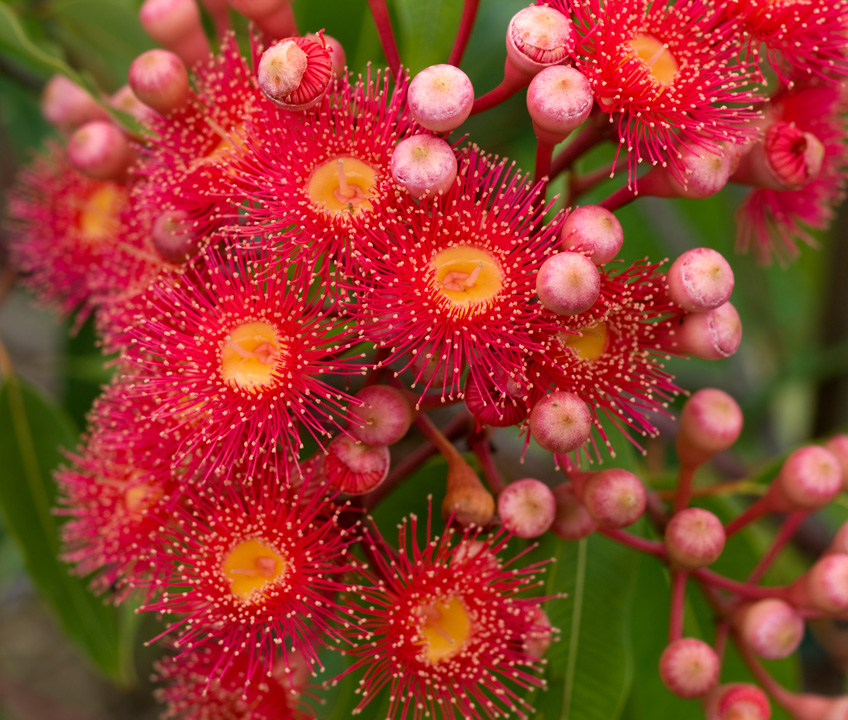
Flowering Gum. Photo – Sherjaca / Shutterstock.com
Check
Ensure mulch on garden beds is 5cm thick to insulate the soil and conserve moisture - you know the drill! Top up before summer heat peaks and, as always,
keep mulch a few centimetres clear of trunks and stems. Where soil is bare add a layer of wet newspaper before mulching to keep weeds down. Raise the
mower blades to the highest cutting setting. This will help achieve the optimal ratio of lawn roots to lawn shoots to keep it green and healthy over
summer. Clear garden debris away from the house and ensure gutters are cleaned to reduce bush fire risk.
Apply
Use soil-wetting agents (not crystals) and water them in well to ensure that irrigation and summer rain penetrates deeply and doesn’t just run off the
surface. Consider using a protective film spray such as Yates DroughtShield on new seedlings and plants, to protect them from heat, sunburn and drying winds. One
spray gives protection for three months. Take care of yourself as well as the garden – wear a hat, slop on the sunscreen and drink plenty of water
while working in the garden.
Plant
Pop in cosmos, zinnia, lupin and extra petunia seeds, plus some verbena seedlings for long-lasting colour.
Tidy
Roll up the hose when it’s not in use and store it in the shade to lengthen its life. We like burying a retractable hose in the garden for maximum disguise.
Bush Garden:
Sydney Red Gum
In my travels around the world, especially Europe, plant lovers like interesting coloured bark. But here it seems people are annoyed by trees that shed
their bark, like the Sydney Red Gum, Angophora costata. But aside from being a good source of free mulch, when the Sydney Rad Gum sheds bark
around this time of year it reveals the bright salmon-coloured trunks that make it really stand out in the bush garden. Angophora costata is quit a common tree in eastern Australia, primarily in sandstone-rich soils or rocky ledges. Although referred to as Sydney Red Gum it is not a Eucalypt.
But like Eucalypts it is extremely long-lived. In fact there are Angophoras on Sydney Harbour that witnessed the arrival of the first fleet!
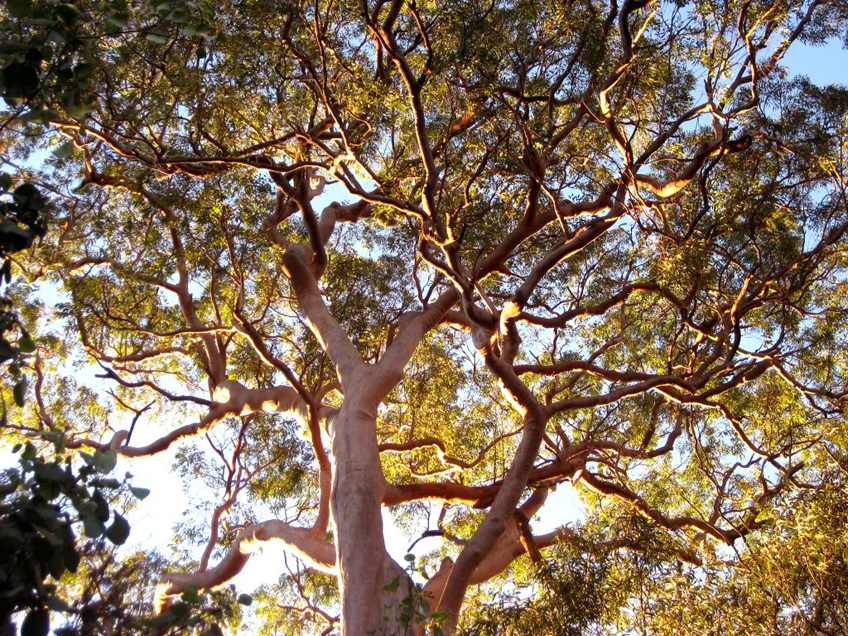
The majestic Angophora costata is known as the Sydney Red Gum. But it isn't a gum at all.
Of course, planting a tree like the Angophora will attract wildlife, like owls, possums and birds to your garden. Thanks to Carmen Bainbridge from the
Blue Mountains for sharing a photo of the Tawny Frog Mouth Owl family nesting in her friend’s garden. The owlet on the left got very excited when Carmen
mentioned that he’d be on the radio this weekend.
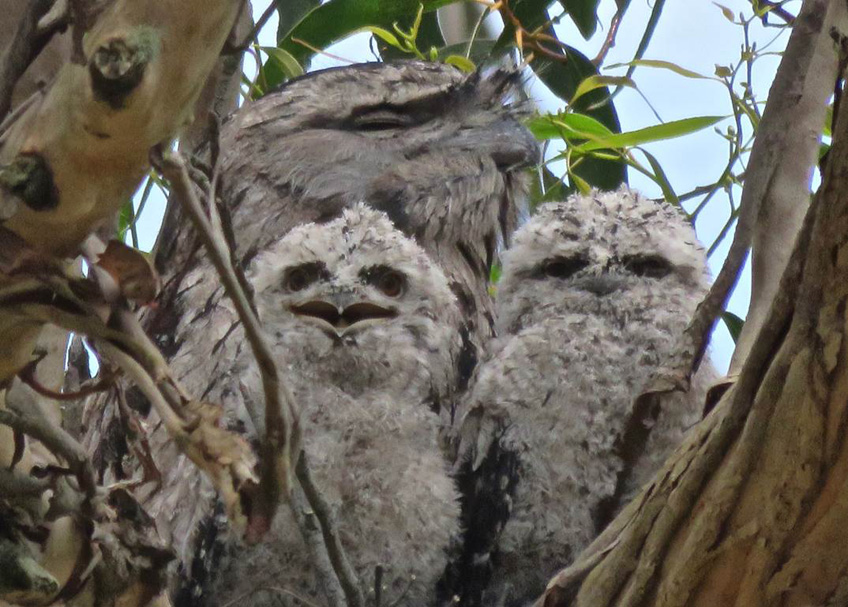
The Tawny Frog Mouth Owl family.
On the subject, you may recall Mikey, the powerful owlet who lives in the Byles Creek Valley. Well, he's growing up fast. Mikey has been photographed enjoying
his first prey.
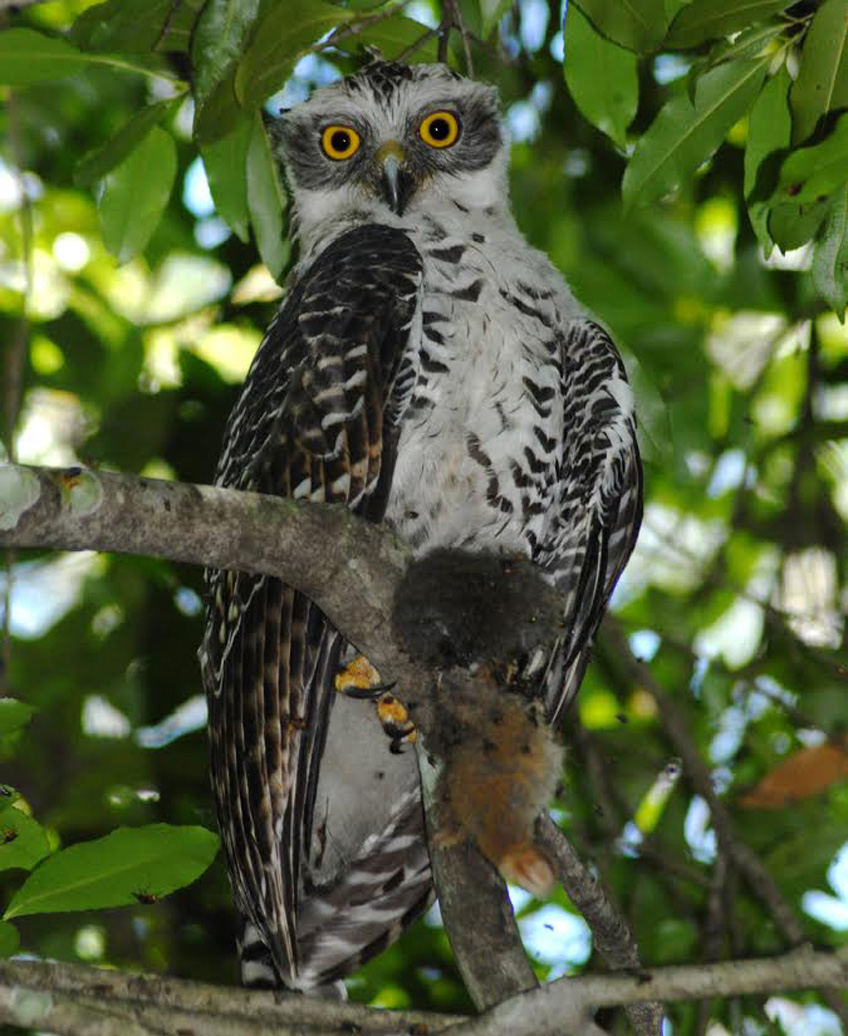
Mikey with his first prey. Photo - Michael Bianchiano
Mikey lives in a pocket of forest less than half an hour from the CBD of the biggest city in Australia. Mikey's parents have lived in the same tree-hollow
for years. This is quite typical for powerful owls. They are very particular about tree hollows. It takes them a long time to find one thats just right
to raise chicks in, and if they lose their chosen home they will not breed again. It's one of the reasons these birds are so rare, and why in Sydney
they have become endangered. Lucky for Mikey, his parents have a great neighbourhood in the tall hardwood forest of the Byles Creek Valley.
But little Mikey has an uncertain future.
A reprieve granted by local council may not be enough to save the habitat of he, and other endangered birds in Mikey's tiny pocket of the northern suburbs
of Sydney. The Byles Creek Valley, which adjoins the Lane Cove National Park will have 80% of the large, mature trees removed to establish an asset
protection zone around residential development if the project is given the go-ahead.
And it is the clearing of such a large percentage of this canopy cover that will all but decimate the population of powerful owl and gang gang, both endangered
birds, that live in the area.
Locals are now calling for the site to be purchased by the state government to incorporate into adjoining national park as a means of protecting endangered
plant and bird species who call the Byles Creek Valley home. Trish Brown is one of the local residents fighting to protect these birds and the Byles
Creek Valley where they live.
Trish told us that the environmental impact reports that developers often rely upon to achieve consent at council state that birds impacted by the removal
of trees will move on to other trees. This not only increases the competition for limited nesting places in remaining forests, but for birds like the
critically endangered gang gang and the powerful owl it means they will no longer breed. Over time this means no more Mikey.
You can voice your concerns with this proposal by emailing Hornsby Council on hsc@hornsby.nsw.gov.au
Bugwatch:
Watch out! Ticks are about
We’re watching out for a very serious bug today- the Tick is out and gardeners need beware. The Karl Mcmanus Foundation, the premiere Lyme Disease research body in Australia, tells us that
Lyme Disease (Borreliosis) is the fastest growing tick borne infection in the world. Borreliosis is a complex infection which can have delayed onset
and broad set of symptoms varying in serverity. Borrelia affects multiple body systems. Untreated it can have high morbidity and mortality.
Borrelia can be transmitted by a tick bite and potentially by any blood sucking insect can transmit Borrelia. So gardeners should take extra care to avoid
bites. Applying a personal insect repellent like Aeroguard can work, but water and sweat will wash it off, and it needs to be reapplied.
One product that has worked for us in the garden is ‘Mitey Shield’.
You can get hold of one by contacting them on (02) 9986 3432.
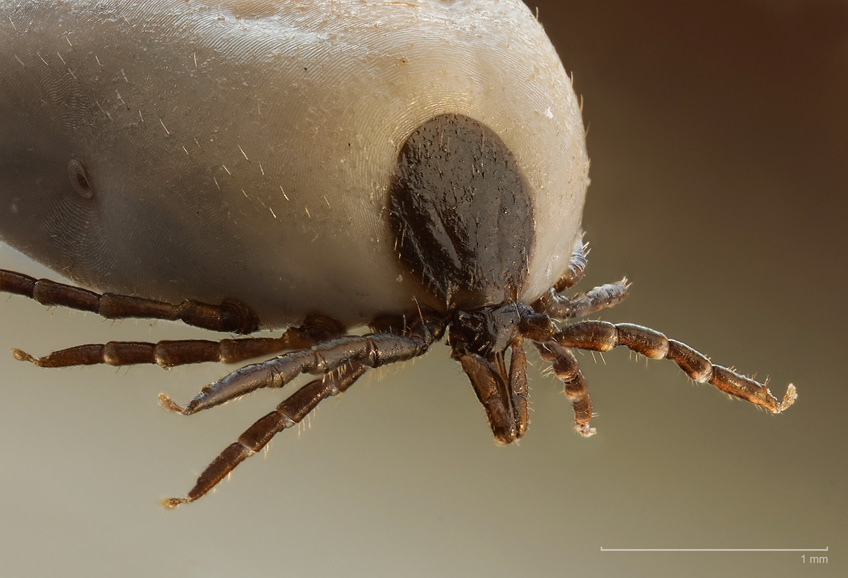
A very close-up image of the Paralysis Tick. Photo - Wikipedia.org
Citrus Leaf Miner
If you’ve noticed those squiggly lines appearing on new leaf growth on your oranges and lemon trees you could have citrus leaf miner. I recorded a video about
controlling citrus leaf miner on the Garden Clinic website. But since
it went to air we’ve added another weapon into the arsenal. If you already have leaf miner use Eco-Neem, as it can penetrate the leaves and deal with the miner inside. Then spray with Eco-Oil to prevent more leaf miner coming.

Lemon leaves showing signs of a Citrus Leaf Miner problem
In the Veggie Patch:
Rosemary ‘Lamb Roast’ is tough, yet dainty. It has a higher oil content and richer flavour. Rosemary can be used to great effect as a low hedge or evergreen
shrub. It’s drought tolerant, pest resistant and easy to grow. Every Aussie garden needs rosemary, and every lamb roast needs it too! Snip off a little
of the fresh new growth to season meats, vegies and sauces – or dry to use as skewers for chicken or lamb kebabs. Yum.
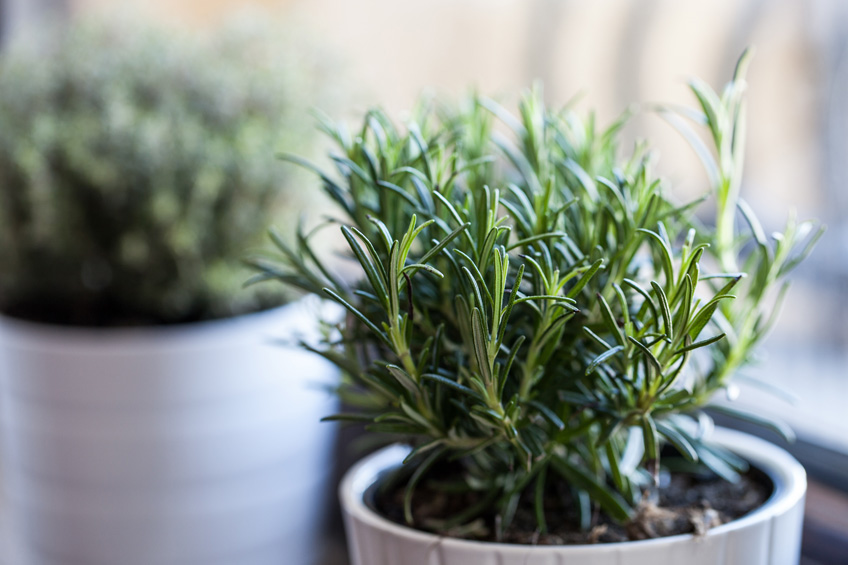
Rosemary is one of my favourite herbs. Photo - Antigoni Lekka / Shutterstock.com
Another great new release from Colourwise is ‘Rhubarb Rhubarb’. Why? Because it’s twice as good as any other rhubarb. This is a superior plant compared
to others on the market, bright red stems appear earlier and it grows so fast you’d think it was bred with privet!
Plant it now and you’ll be eating rhubarb pie for Christmas.
What’s On:
My Adventure at Everglades
Children can learn about heritage conservation and the natural environment in one of the most enchanting historic properties in the Blue Mountains these
school holidays – and they won’t even know it’s educational. My Adventure at Everglades children’s program will begin at Everglades Historic House
& Gardens at Leura during the long December/January summer holidays. The My Everglades Adventure program will start during the 2015 summer school
holidays. Everglades Historic House & Gardens, 37 Everglades Ave, Leura, is open from 10am to 5pm daily during daylight savings and from 10am to
4pm during autumn and winter. Entry: $13 adults, $8 concessions, $4 children, National Trust members free.
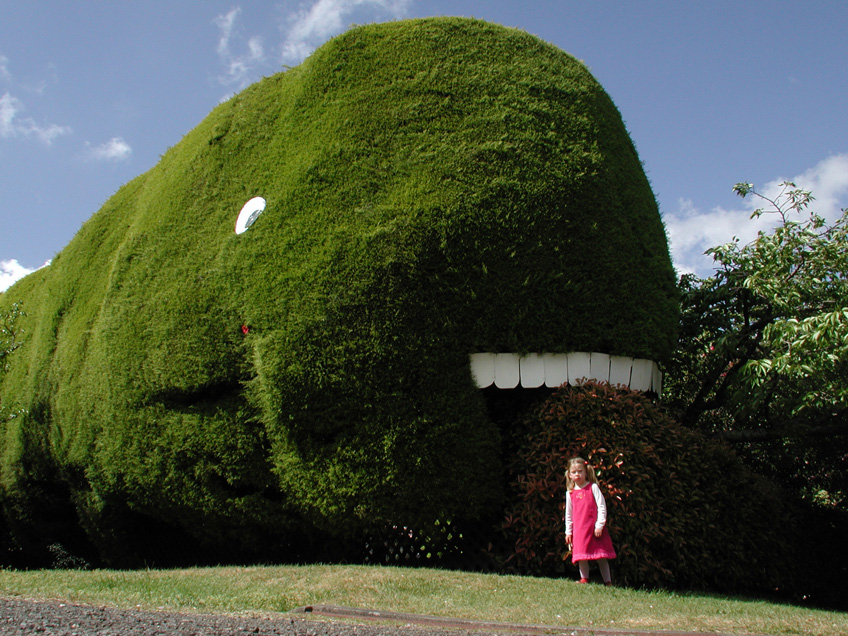
The kids will have a whale of a time at the Everglades
To find out more contact the Everglades on (02) 4784 1938 or email evergladesgarden@bigpond.com
Come away with us:
The Top End tour is a favourite of mine that we haven’t run for many years. I’m delighted it’s back, and I’m sure you will be too.
We travel in style across the unforgettable landscapes of the Kimberley, Kununurra, Katherine and Kakadu. We see gorgeous gorges, waterfalls and ancient
rock art. You will get to know the wildflowers along the way with our friend, and expert guide, Angus Stewart. It’s a journey through the spiritual
heartland of Australia not to be missed.
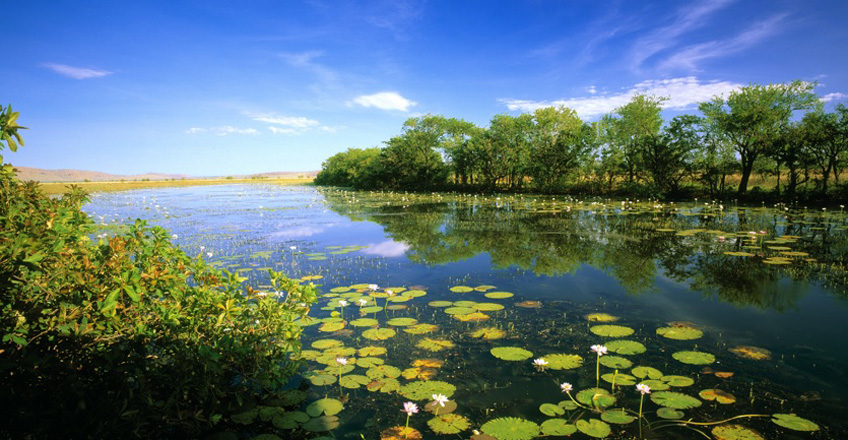
One of many beautiful wetland scenes on the 2016 Top End tour led by Angus Stewart
Garden News:
Angus Stewart’s Australian Native Garden
Ever wondered why landscape and garden designers don’t use native plants more commonly in their gardens? Angus Stewart certainly has. His new book, ‘The
Australian Native Landscape’ was written to inspire and guide landscapers and gardeners in the quest for a garden that captures the spirit of the Australian
landscape.

Angus Stewart. Photo - allenandunwin.com
Angus and his friend, horticulturist and co-author AB Bishop have put together a book that will show how to combine new native plant cultivars with indigenous
plants from your local area to create a garden that will attract wildlife, provide bush foods as well as give you a garden that will blend in with
natural environments that may adjoin your property.
As well as an extensive list of new native plant releases from the last few years, there are also practical chapters on pests and diseases, propagation,
bush foods, garden design and new planting methods. Angus and AB will also take you on a journey around Australia looking for inspiration in wild areas
and wonderful native gardens.
What Have We Done?
The Wollomi Pine is something all Australians should be proud of. But curiosity about it’s location in the wild may have placed this stand of ancient trees
in critical danger.
There are two populations of Wollomi Pine trees naturally occurring in the Blue Mountains National Park. The location of these stands is kept secret as
part of a thorough management strategy implemented to protect the trees.
The age of the species is estimated to be between 90 and 200 million years - long before dinosaurs.
Back when this stand of Wollomi Pine was discovered the director of the Botanic Gardens Trust at the time, Carrick Chambers, decided it should be propagated
and made available for retail sale as part of the strategy to keep the species alive, knowing that if disease were able to enter the site of the natural
colony it would decimate the tree and we would lose this living dinosaur forever.
Sadly it appears disease has been introduced at the site in spite of these efforts. Phytophthora, most likely on the soles of shoes of intruders to the
site, is infecting and killing the only wild stand of Wollomi Pine trees in the world. The Wollomi Pine is now on the critically endangered list. It
is now unlikely to survive in the wild.
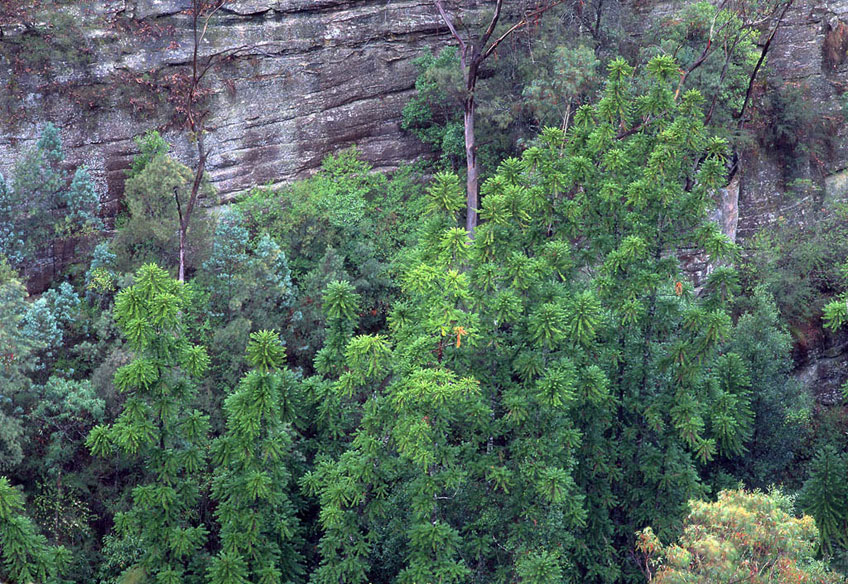
Now critically endangered, the only wild stand of Wollomi Pine trees in the world. Photo - Jamie Plaza
My Park Rules
From hidden tree top cubbies, wetlands, lizard dens to bug hotels and forest swings - My Park Rules has captured the imagination of school communities
all over Australia. Over the last eight weeks almost 100 entries have been received from kindergartens, day care centres, primary
and high schools. Combined, these entries have gathered more than 30,000 votes!
And the My Park Rules Finalists from each state are:
Marrickville Public School (NSW)
Baden Powell College (VIC)
Indooroopilly State School (QLD)
Highgate Primary School (WA)
Snug Primary School (TAS)
Telopea Park School (ACT)
St John's Early Learning Centre (SA)
Centralian Senior College (NT)
This is just the beginning of our quest to make sure every child in Australia has access to well-designed green space and all of the terrific benefits
that flow as a result. The overall winner for the My Park Rules initiative will be announced on 1 May 2016.